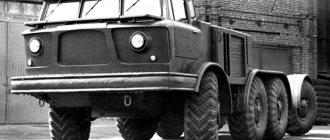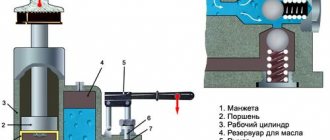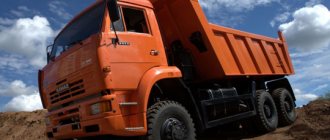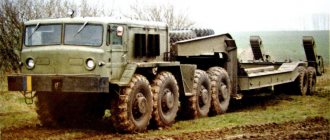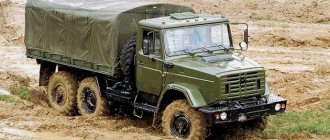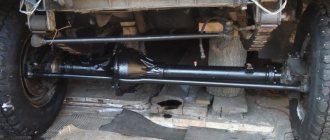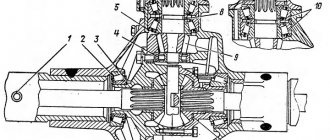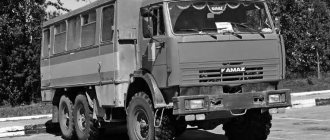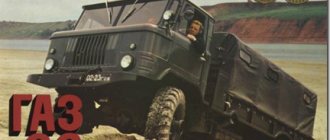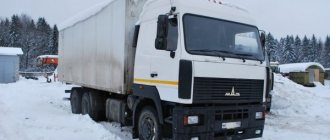The exhibit, called MAZ 543, was developed as the best all-wheel drive vehicle, which in design did not differ from its world analogues. The most interesting thing is that this four-axle giant is created exclusively from domestically produced parts.
Initially, the engineers were faced with the task of developing a missile carrier; later the 543rd base became universal for a wide variety of systems and additional equipment. As a result, the heavy vehicle became one of the most popular in the USSR military-automotive complex.
The appearance of a new Soviet military vehicle MAZ-543
After the Minsk Automobile Plant mastered the production of MAZ 537 series, a group of engineers was sent from Yaroslavl to Minsk, whose task was to develop a new military vehicle, using the base and developments that were used to create the MAZ-537.
The MAZ-543 car began to be developed at the end of the 1950s. For this purpose, special design bureau No. 1, under the leadership of Shaposhnikov, used all its knowledge accumulated since 1954. With the help of engineers from Yaroslavl, by 1960 the MAZ-543 chassis project was ready. The Soviet government responded very quickly to this news and on December 17, 1960, issued a decree that obliged the production of the MAZ-543 chassis to be launched as soon as possible.
After 2 years, the first 6 samples of the MAZ-543 chassis were ready. Two of them were immediately sent to Volgograd, where experimental missile launchers and R-17 ballistic missiles with a liquid-propellant jet engine were installed on the MAZ-543 chassis.
The first completed missile carriers were sent to the test site in Kapusny Yar in 1964, where the first design tests were carried out. During the testing process, the MAZ-543 chassis showed its good side, since SKB-1 had experience in developing similar vehicles since 1954.
An unexpected decision regarding the choice of cabin layout for the MAZ-543
The new missile system, called Temp-s, had a very long missile (12,380 mm), so the chassis length was clearly not enough. It was decided to make a special recess in the middle of the cabin, but this could not be implemented. Since all that remained was to lengthen the frame, chief designer Shaposhnikov made a very bold and extraordinary decision - to divide the large cabin into two isolated ones, between which the head of the rocket was located.
Such a division of the cabin has never been used on such equipment, but this method turned out to be the only correct solution. Subsequently, most of the predecessors of the MAZ-543 had cabs of this type. Another original solution was the use of new material to create the MAZ-543 cabins. They were not made of metal, but of polyester resin, which was reinforced with fiberglass.
Although there were immediately many skeptics who argued that it was unacceptable to use a material resembling plastic for the cabin, tests of the cabin proved the opposite. During testing under shock load, the test stand collapsed, but the cabin itself survived.
Mounted armor plates were developed specifically for the cabin. Since the MAZ-543 had to fit into the railway format, the cabins received 2 seats each, and the seats were not located in a row, but one after another.
Modern MAZs
MAZ 543 (MAZ 7310 or “Hurricane”) was replaced over time by the “Oplot” family of vehicles. True, their production never took the form of “serial production”. They were designed to carry even more powerful weapons. Thanks to the creation of their predecessors, it was possible to produce new road trains capable of transporting loads of 75-100 tons. Designer B.L. Shaposhnik was awarded the title of Hero of Socialist Labor. He became a laureate of the Lenin and State Prizes of the USSR. Now all manufactured products are marked MZKT instead of the usual MAZ.
Car models are produced for collectors in Kazan on a scale of 1 to 43. They are made of metal and plastic. In the game "Truckers" they used the MAZ 7310 model to create the "Storm" truck. And in the game Spin Tires the same vehicle was called E 7310.
Technical characteristics of MAZ-543
When designing the MAZ-543, many original design solutions were used:
- The original frame consisted of 2 bent spars of increased elasticity. For its production, welding and riveting technologies were used;
- In order to ensure the necessary smoothness, an independent torsion bar type suspension was chosen;
- The transmission was also very original. The four-speed hydromechanical gearbox made it possible to change gears without interrupting power;
- The vehicle's cross-country ability was ensured by 8 drive wheels, each of which had an automatic inflation system. By adjusting the tire pressure, it was possible to achieve high cross-country ability even on the most difficult off-road areas;
- The D-12A-525 tank engine provided the vehicle with the necessary power reserves. The volume of this 12-cylinder 525 horsepower engine was 38,880 liters;
- The car had 2 fuel tanks with a capacity of 250 liters each. There was also an additional aluminum tank with a capacity of 180 liters. Fuel consumption could range from 80 to 120 liters per 100 km;
- The chassis load capacity was 19.1 tons, and the vehicle's own weight was about 20 tons, depending on the modification.
The dimensions of the MAZ-543 chassis were dictated by the dimensions of the rocket and launcher, so they were indicated in advance in the technical specifications:
- The length of the MAZ-543 was 11,265 mm;
- Height – 2,900 mm;
- Width – 3,050 mm.
Thanks to the separate cabins, it was possible to place the Temp-S launcher on the MAZ-543 chassis without any problems.
Operation of military equipment
Drivers who have undergone appropriate training are allowed to drive such a huge vehicle. First of all, it is necessary to pass exams on technical knowledge. parts, safety precautions and, of course, driving itself. In general, the standard vehicle crew consists of two people, so you need to act together.
New equipment will definitely be tested. First after 1000 km. mileage, the first maintenance is carried out. Then, after two thousand kilometers, the oil is changed.
Before starting the engine, the driver pumps the lubrication system using a special pump (pressure up to 2.5 atm) for no more than one minute. If the temperature is below 5 degrees, the engine must be warmed up before starting: there is a special heating system for this.
After stopping the engine, restarting is allowed only after 30 minutes. After washing at low temperatures, the power plant is started to remove water from the turbine.
It happened that the vehicle stood idle for a long time at an ambient temperature of less than 15 degrees. Then the hydromechanical gearbox with overdrive switched off on its own.
It is worth noting that reverse gear is only activated after a complete stop. When driving on hard surfaces and dry ground, a higher gear is engaged, and in off-road conditions, a lower gear is engaged.
When stopping on a slope of more than 7 degrees, in addition to the hand brake, the brake master cylinder drive is used. Parking should not exceed 4 hours, otherwise wheel chocks should be installed.
Basic model MAZ-543
The very first representative of the MAZ-543 family of vehicles was a base chassis with a payload capacity of 19.1 tons, which was called MAZ-543. The first chassis under this designation were assembled in the amount of 6 copies in 1962. In total, 1,631 copies were produced throughout the entire history of production.
A number of MAZ-543 chassis were sent to the GDR army. There they were equipped with tented all-metal bodies, which could be used both for transporting goods and for transporting personnel. Additionally, MAZs were equipped with powerful towing devices, which turned them into powerful ballast tractors. Those vehicles that were not used as tractors were converted into mobile workshops or repair and recovery vehicles.
The MAZ-543 was originally created to accommodate tactical missile systems on its chassis. The first complex that was placed on the MAZ-543 chassis was “TEMP”. After this, a new 9P117 launcher began to be mounted on the MAZ-543 chassis.
The following complexes and systems were also installed on the MAZ-543 base:
- Coastal missile system "Rubezh";
- Combat control points;
- Special military truck crane 9T35;
- Communication stations;
- Diesel autonomous power plants.
There were also other specific equipment mounted on the MAZ-543 base.
Characteristics of the basic version
The all-wheel drive truck of the MAZ 7310 modification is equipped with an onboard platform and belongs to the class of heavy wheeled tractors. Technical characteristics of MAZ 7310 (basic version):
- dimensions 11657/2975/2950 mm (length/width/height);
- front and rear track – 2375 mm;
- ground clearance - 400 mm;
- turning radius 13500 mm;
- total weight up to 43.3 tons, loaded - 23 tons, load capacity - up to 20 tons;
- when towing a trailer, its weight is up to 65 tons.
The engine for this tractor model was powerful diesel units of the D-12-525A series based on the V-2 engine, which was actively used in tank equipment. Jet fuel atomization and water cooling are implemented here. The “8 by 8” wheel arrangement when equipped with such an engine provides high traction even for such heavy vehicles and allows you to move heavy loads over long distances.
The engine displacement is 38.8 liters, rated power is 525 horsepower. The declared service life of the engine is 55 thousand km. Fuel consumption is one of those points that does not allow these cars to be actively used for civilian purposes - up to 125 l/h. The basic version has two fuel tanks with a capacity of 420 liters; the capacity can be increased to 1220 liters.
The gearbox determines how many speeds are in the MAZ 7310. Here it is three-speed, manually controlled, mechanical.
Features of MAZ-543A
In 1963, an experimental modification of the MAZ-543A chassis was produced. This model was intended for installation of the Temp-S OTRK SPU. The MAZ-543A modification began to be produced in 1966, and serial production was launched only in 1968.
Especially to accommodate the new missile system, the base of the new model was slightly increased. Although at first glance no differences are visible, in fact the designers slightly increased the front overhang of the car, moving the cabins forward. Thanks to an increase in the front overhang by 93 mm, it was possible to lengthen the useful part of the frame to 7 meters.
New modifications of the MAZ-543A were primarily intended for installation of the Temp-S launcher and the Smerch multiple launch rocket system on their bases. It is noteworthy that although the Temp-S launchers have long been removed from service with the Russian Ground Forces, the Smerch multiple launch rocket systems are still in service with the Russian army.
The MAZ-543A modification was produced until the mid-2000s. In total, about 2,600 chassis were produced over the years. Subsequently, the following equipment was installed on the MAZ-543A chassis:
- Truck cranes of various lifting capacities;
- Command posts;
- Communication complexes;
- Power plants;
- Various workshops.
In addition to the above, other specific military equipment was installed on the MAZ-543A base.
Various prototypes and small-scale vehicles produced on the basis of the MAZ-543
Since modernized launchers with increased dimensions appeared in the early 70s, the question arose about the development of new modifications of the MAZ-543 chassis. The first experimental development was the MAZ-543B, assembled in two copies. They served as a chassis for installing the modernized 9P117M launcher.
Since new launchers required a longer chassis, a modification of the MAZ-543V soon appeared, on the basis of which the MAZ-543M was designed in the future. The MAZ-543M modification was distinguished by the presence of only one cabin, which was significantly moved forward. Such a chassis made it possible to place larger installations or equipment on its base.
For various transport operations both in the army and in the national economy, a small-scale modification of the MAZ-543P was developed. This machine was dual-purpose. It was used both for towing trailers and artillery pieces, and as training vehicles.
There were also virtually unknown modifications that were produced in single copies as experimental models. These include the MAZ-543D modification, which has a multi-fuel diesel engine that could run on both diesel fuel and gasoline. Unfortunately, due to the complexity of production, this engine never entered mass production.
Also interesting is the MAZ-543T prototype, the so-called “Tropic”. This modification was specifically designed for use in mountainous and desert areas.
Modifications
The MAZ-537A ballast tractor had a cargo platform for placing ballast, and its use as a flatbed truck was not intended. In addition, it had a winch, which was missing on the basic version. The MAZ-537B was supposed to become a launcher for operational-tactical missiles, but due to the insufficiently strong frame it did not go into production. The MAZ-537V received a rearward coupling device, which made it possible to tow the Yastreb UAV launcher. The MAZ-537G differed from the original tractor only in the presence of a standard winch.
The MAZ-537D was supposed to tow trailers with special equipment. To ensure its operation, a generator driven from the power take-off was installed on the truck. MAZ-537E, designed to work with active semi-trailers, had a semi-trailer wheel drive generator, also powered from the power take-off. The MAZ-537K crane was not widely used; the export version of the MAZ-537T tank transporter turned out to be too expensive to produce.
For use as an airfield tractor, the MAZ-537L was developed in Kurgan with a ballast platform instead of a fifth wheel hitch and an extended frame.
The MAZ-537P was a modernization of the “A” series, from which the winch was removed - as it turned out, it was used very rarely during operation. The MAZ-537R was an attempt to create a civilian version for the construction of oil pipelines. It had to be operated in tandem with a dismantling trailer and transport pipes.
Features of MAZ-543M
In 1976, a new, most popular modification of the MAZ-543 appeared. The prototype model, which was named MAZ-543M, was tested for 2 years. This car was put into service immediately after its debut. This modification has become the most successful in the MAZ-543 family. Its frame was the longest in its class, and the vehicle's load capacity was increased to 22.2 tons. The most interesting thing about this model was that all the components and assemblies were absolutely identical to the components of other models of the MAZ-543 family.
The most powerful Soviet launch systems, anti-aircraft launch systems and various artillery systems were installed on the MAZ-543M chassis. Various special add-ons were also installed on this chassis. During the entire production period of the MAZ-543M modification, more than 4,500 units of cars were produced.
Of great interest is the list of specific support equipment installed on the MAZ-543M chassis:
- Mobile dormitories designed to accommodate 24 people. These complexes have ventilation, microclimate, water supply, communications, microclimate and heating systems;
- Mobile canteens for combat crews.
These cars were used in remote areas of the USSR, where there were no settlements or places to live.
After the collapse of the Soviet Union, mass production of MAZ-543 vehicles of all three modifications was practically discontinued. They were produced strictly to order in small batches until the mid-2000s.
In 1986, the license to assemble the MAZ-543 was sold to the Chinese company Wanshan, which still produces them.
Fire trucks MAZ-543 “Hurricane”
MAZ-543 Hurricane fire trucks were designed specifically for service at Soviet airfields. Many vehicles of this series are still in use at CIS airfields. Firefighters MAZ-543 have a water tank of 12,000 liters. There is also a 900 liter foam tank. Such characteristics make these vehicles indispensable assistants in the event of a sudden fire at the airfield. The only drawback is the high fuel consumption, which reaches 100 liters per 100 km.
Currently, cars of the MAZ-543 family are gradually being replaced by new MZKT-7930 cars, although this process is going very slowly. Hundreds of MAZ-543 continue to be on combat duty in the armies of Russia and the CIS.
Dimensions and weight
MAZ 543 has an own weight of 23,000 kg. Load capacity is 20,000 kg. The maximum trailer weight is allowed up to 25,000 kg. The total weight of the vehicle can be 43,300 kg.
Dimensions: length – 11657 mm, width – 2975 mm, height – 2950 mm.
Base size: 2200 mm + 3300 mm + 2200 mm. The track is 2375 mm.
Ground clearance: 400 mm.
MAZ 543, the photo of which is presented below, can reach speeds of up to 60 km/h.
